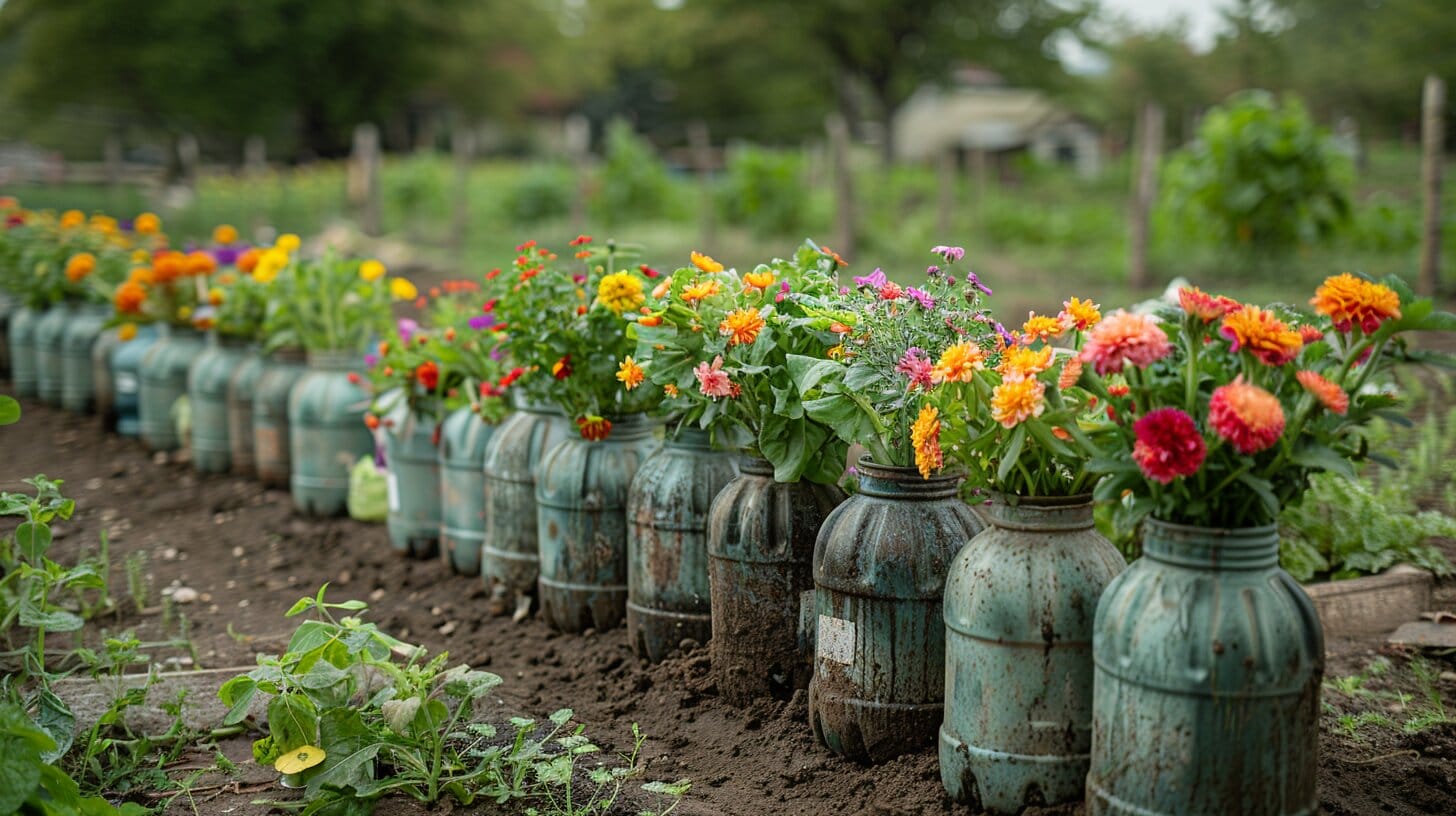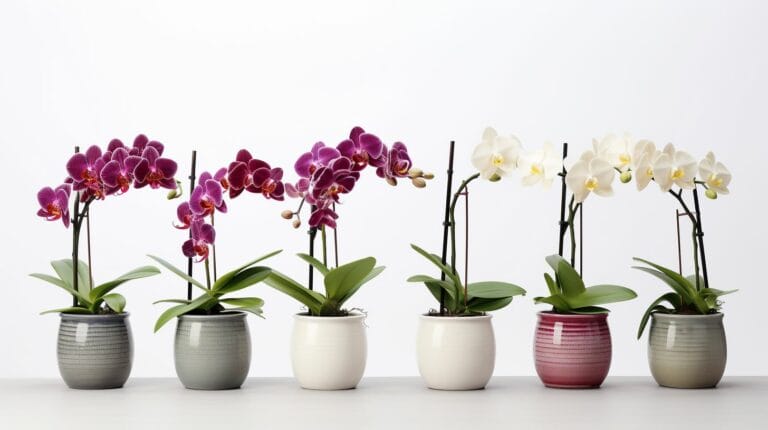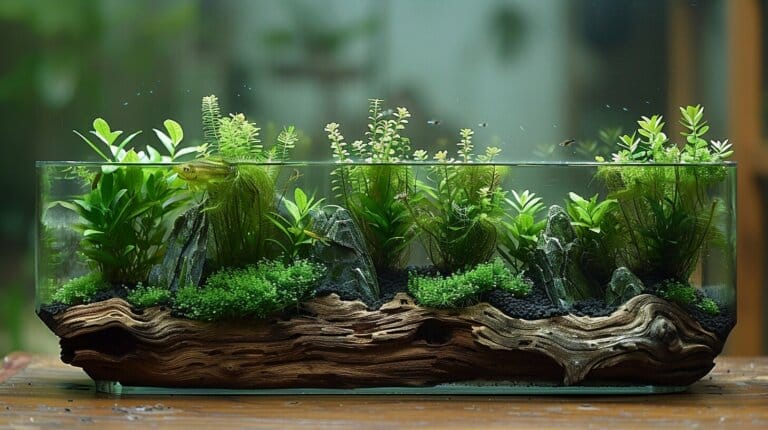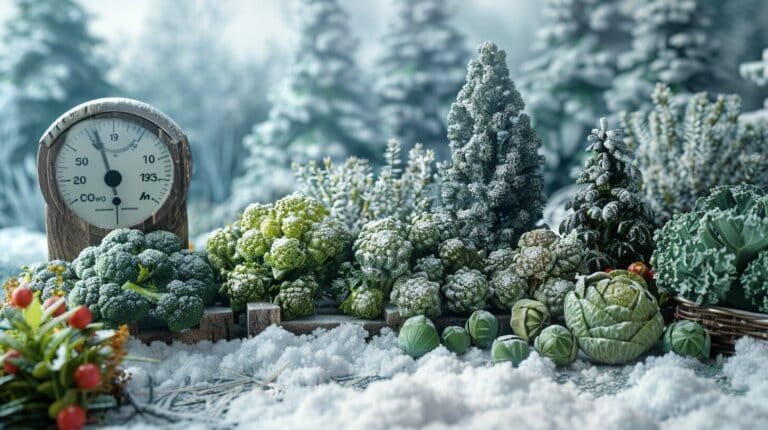Harnessing the Power of Milk Jugs in Garden 2024: Sustainable Gardening Solutions
The modest milk jugs in the garden become a revolutionary tool in the field of sustainable gardening in 2024. Utilizing its capabilities pave the way for numerous opportunities to improve plant growth and durability.
From boosting seed germination rates to conserving water, milk jugs prove to be versatile allies in our gardening endeavors. As we unveil the transformative impact of this simple yet ingenious method, prepare to witness how a common household item can revolutionize our approach to cultivating green spaces.
Key Takeaways
- Repurpose milk jugs as mini greenhouses for early planting and extended growing seasons.
- Cultivate seedlings effectively with milk jug greenhouses, protecting them from harsh conditions.
- Utilize milk jugs for efficient drip irrigation, promoting healthy plant growth and water conservation.
- Transform milk jugs into versatile garden tools for seed starting, fertilizing, and protecting plants.
Repurposing Milk Jugs for Garden Use: A Sustainable Approach
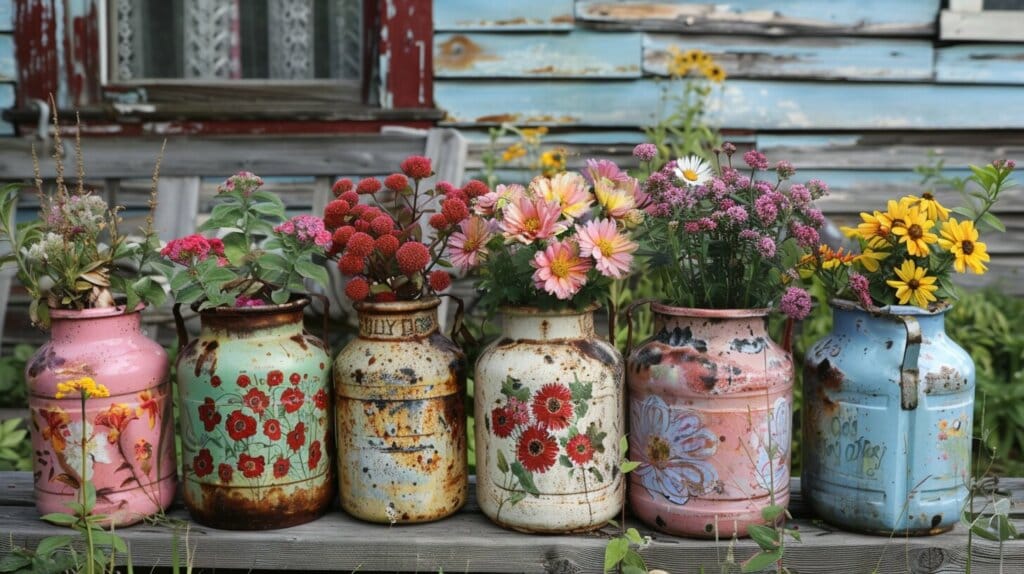
Repurposing milk jugs for garden use offers a sustainable and cost-effective solution. By transforming them into makeshift greenhouses, gardeners can sow seeds earlier, extend the growing season, and provide protection from harsh weather conditions for healthier plants.
This creative recycling method not only reduces waste but also creates a warm, moist environment ideal for seed germination, conserves water, and supports eco-friendly gardening practices.
Cultivating Seedlings in Milk Jugs: The Basics of Winter Sowing

Winter sowing seedlings in milk jugs is an efficient method to kickstart gardening in cold weather, providing a head start and protection from harsh elements. Here are some key points to consider when using milk jugs for winter sowing:
- Winter Sowing: Plant seeds in containers during winter to leverage natural cold stratification for optimal germination when conditions are favorable.
- Milk Jug Greenhouse: Creating a milk jug greenhouse is a simple DIY project: cut a milk jug in half, add soil and seeds, seal it to create a mini greenhouse effect.
- Transplanting: Transplant sprouted seedlings from milk jugs to garden or larger containers without disturbing their roots once the weather warms up.
- Sustainable Gardening: Reusing milk jugs for winter sowing promotes sustainable gardening by reducing waste and offering a cost-effective plant nurturing method.
Milk Jug Irrigation Systems: Efficient Watering with Drip Irrigation
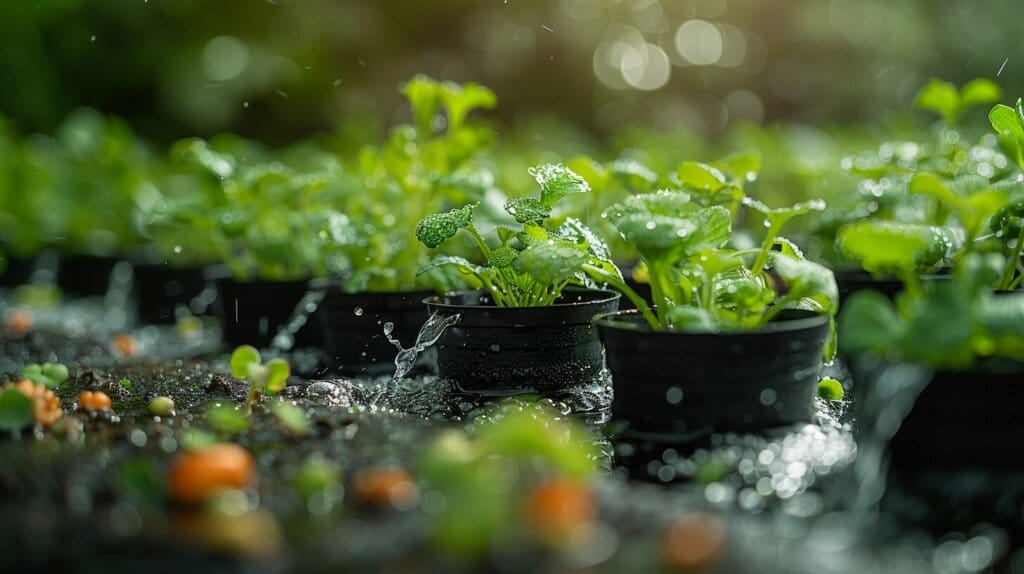
Utilize a sustainable milk jug irrigation system with drip technology to efficiently water your garden, reduce waste, and promote sustainability. Repurpose old milk jugs for drip irrigation to deliver water directly to plant roots, minimizing evaporation and runoff.
Create small holes in the jug’s bottom for controlled water release, ensuring plants receive consistent watering for healthy growth and water conservation. Benefits include reduced water usage, weed prevention, and lower risk of plant diseases.
Simply fill the jugs with water, place them near plant bases for gradual seepage, supporting plant health and environmental responsibility by upcycling plastic waste in gardening practices.
Milk Jugs In Garden: From Seed Starting Pots to Fertilizer Containers
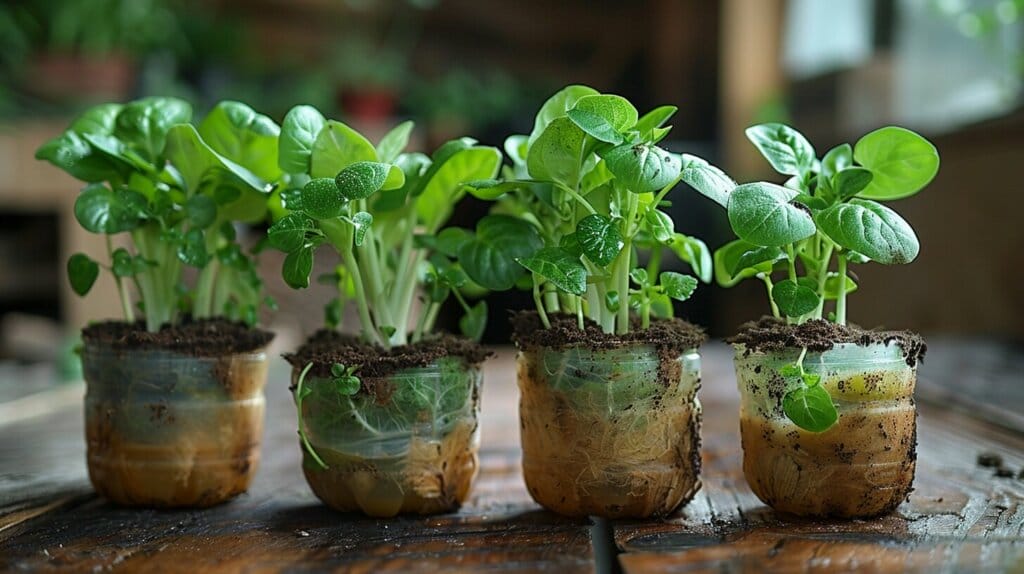
In sustainable gardening, we consider milk jugs in garden as versatile tools for seed starting and fertilizer containers, utilizing their availability and adaptability to nurture the garden. Here’s how we make the most of them:
- Seed Starting: Cut the top of the milk jug to create a mini greenhouse for starting seeds. This provides a warm and moist environment ideal for seed germination.
- Transplanting: Once the seeds have sprouted, the jug can be used as a temporary container for young plants before they’re ready to be transplanted into the garden. This protects delicate roots during the early stages of growth.
- Fertilizer Container: By repurposing a milk jug as a fertilizer container, you can easily mix and distribute nutrients to your plants. This helps in feeding them and promoting healthy growth.
- Drainage: Proper drainage is essential for plant health. Drilling small holes in the bottom of the milk jug allows excess water to escape, preventing waterlogging and root rot.
- Versatility: Beyond seed starting and fertilizing, milk jugs can serve in various other gardening tasks, showcasing their adaptability and usefulness in the garden.
Can I Use Milk Jugs for Watermelon Plants in Limited Space Gardening?
Yes, you can use milk jugs for growing watermelons in buckets. This method is perfect for limited space gardening. Simply cut the top off the milk jug, fill it with soil, and plant your watermelon seeds. It’s a great way to grow watermelons in buckets and save space!
Protecting Your Garden with Milk Jug Mini Greenhouses
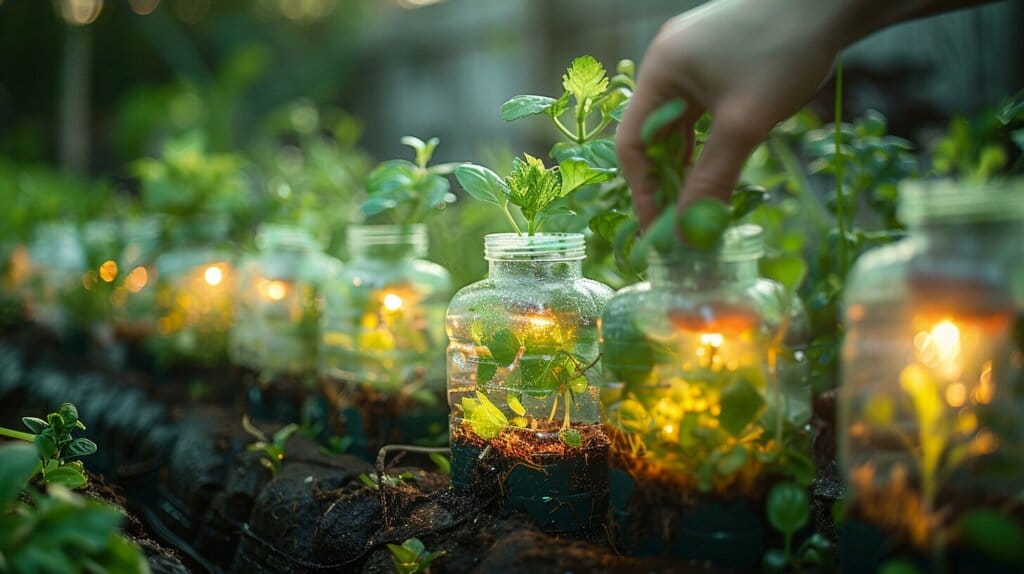
Using milk jugs as mini greenhouses is a cost-effective way to protect your garden from harsh weather and extend the growing season.
These DIY solutions safeguard plants against frost and cold temperatures, creating a simple and effective barrier for maintaining a warmer environment for garden beds or indoor seeds.
Benefits of Milk Jug Mini Greenhouses:
| Benefit | Description | Example |
|---|---|---|
| Frost Protection | Shields plants from freezing temperatures, preventing damage | Covering tender seedlings at night |
| Extended Growing Season | Allows for planting earlier in spring or later in fall | Starting seeds indoors for transplant |
| Cost-Effective | Utilizes recycled materials, reducing the need for purchasing new supplies | Saving money on commercial covers |
Cut a milk jug in half, fill the bottom with soil, plant seeds or seedlings, cover with the top half, and add ventilation holes. This budget-friendly method creates a protective mini greenhouse for nurturing your plants effectively.
Conclusion
Let’s raise a toast to the power of milk jugs in sustainable gardening! By repurposing these everyday items, we’ve unlocked a world of possibilities for extending our growing season, promoting successful germination, and conserving water.
Embracing eco-friendly practices like using milk jugs as mini-greenhouses not only benefits our plants but also contributes to a greener future.
Let’s continue to innovate and explore new ways to make our gardens more sustainable and environmentally friendly. Cheers to a greener tomorrow!
Frequently Asked Questions
Is It Safe to Grow Vegetables in Milk Jugs?
Yes, growing vegetables in clean, prepared milk jugs in garden is safe. The HDPE material is considered safe for this purpose. Thorough cleaning, proper drainage, quality soil, and regular monitoring are essential for successful vegetable growth in milk jugs.
How Do You Make a Milk Jug Greenhouse?
We cut the top off a clean gallon jug, make drainage holes, fill net cups with soil, plant seeds, place pots inside, secure with tape, keep soil moist, give sunlight, watch growth, and transplant carefully for successful gardening using milk jugs in garden.
What Is Milk Jug Gardening?
Milk jug gardening involves repurposing plastic jugs as mini greenhouses for seedlings. It’s a cost-effective, eco-friendly method suitable for beginners and urban gardeners. By protecting plants and promoting recycling, it offers a simple yet impactful gardening solution.
How Do You Cut Milk Jugs for Plants?
To cut milk jugs for plants, we use sharp scissors or a utility knife. Carefully cut them horizontally, ensuring smooth edges. The bottom half becomes a mini greenhouse, while the top acts as a dome for temperature control which makes milk jugs in garden viable.

